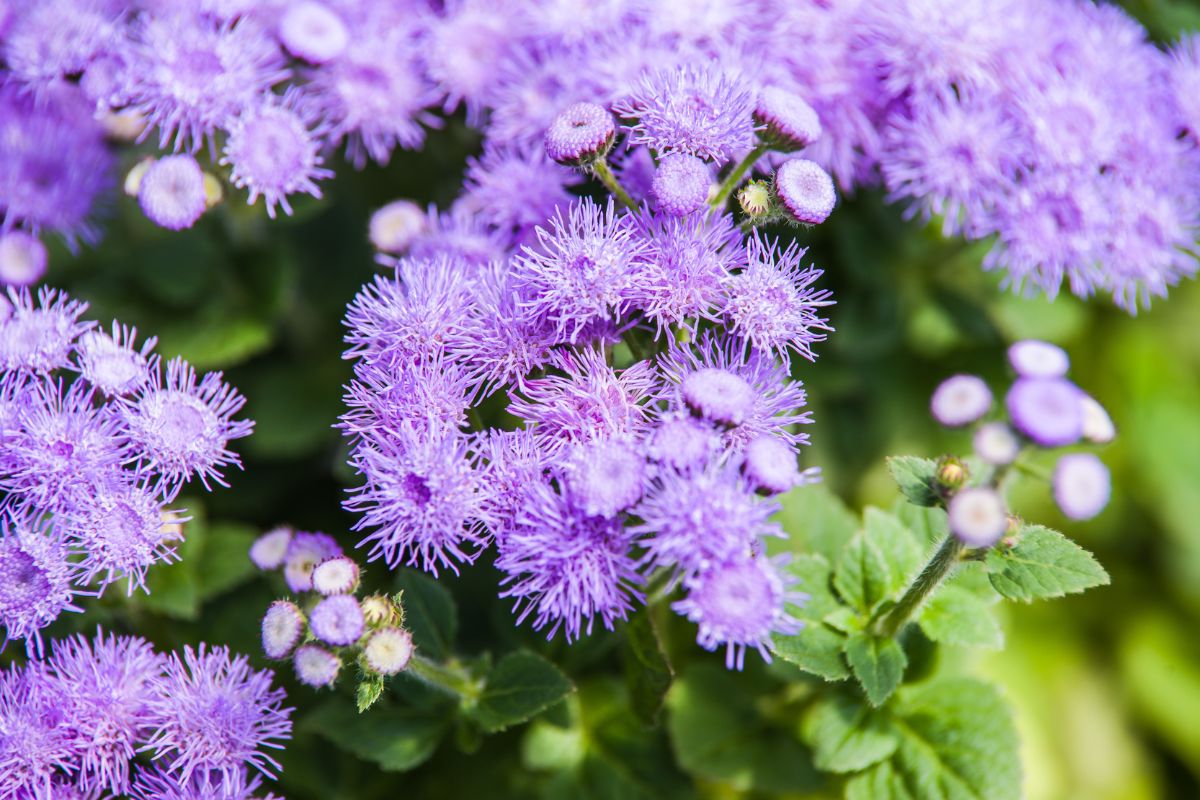Show table of content Hide table of content
Looking for a flower that brings continuous color to your balcony all season long? The ageratum might be exactly what you need. With its fluffy, pompom-like blooms that keep flowering from spring until the first frost, this charming plant offers a fantastic alternative to the ubiquitous geraniums seen on balconies everywhere.
Ageratum: the magical alternative to traditional balcony flowers
Native to Central America and Mexico, Ageratum houstonianum belongs to the Asteraceae family and stands out with its distinctive fuzzy flower clusters. These delightful pompoms create a continuous display of color that transforms ordinary planters into eye-catching features on any balcony or terrace.
Unlike many flowering plants that require regular deadheading, ageratums maintain their blooming cycle naturally. This self-cleaning quality makes them particularly valuable for busy gardeners or those who, like some unique species that have evolved in isolation, have adapted to thrive with minimal intervention.
Garden All good gardeners do this simple action to prevent aphids on rose bushes.
Height varieties range from compact 15cm dwarf cultivars perfect for container edges to taller 60cm varieties ideal for the back of planters. The ‘Hawaii’ and ‘Artist’ series offer shorter options around 15-20cm, while ‘Blue Horizon’ can reach impressive heights of 50-60cm, creating depth in your container arrangements.
Though commonly known for its lavender-blue shades, ageratum also comes in white, pink, and violet hues. This color diversity allows for creative combinations with other balcony favorites. The ‘Blue Mink’ variety remains popular for its classic blue pompoms, while ‘Red Sea’ offers striking pink-red blooms that stand out in any arrangement.
Why ageratum outperforms geraniums for balcony gardeners
The exceptional flowering period of ageratum gives it a significant advantage over many traditional balcony plants. From May until the first autumn frosts, these plants provide nearly six months of continuous blooms without the flowering gaps common in other species. This non-stop performance means your balcony remains colorful throughout the entire season.
Unlike geraniums that require regular deadheading to stimulate new flowers, ageratums naturally shed spent blooms. This self-maintaining feature significantly reduces maintenance time, making them ideal for those with busy schedules. The plant’s natural tendency to maintain a compact form also eliminates the need for pruning – simply pinch young stems early in the season to encourage branching.
Garden A simple cup at the base of your raspberry bushes – your harvest will double.
Ageratums also demonstrate remarkable resilience to urban conditions. They tolerate both full sun and partial shade positions, adapt well to container growing, and show good drought resistance once established. This adaptability makes them suitable for various balcony exposures, even challenging south-facing locations where temperatures can soar during summer months.
Disease resistance represents another significant advantage over geraniums. While pelargoniums can suffer from rust and botrytis, ageratums remain relatively problem-free throughout the growing season. This robustness, combined with their typically lower purchase price, makes them an economical choice for balcony gardeners seeking value.
Creating stunning balcony displays with ageratum
Ageratums excel in mixed container plantings where their rounded form and continuous flowering create cohesive displays. For a “Summer Sky” themed planter, combine blue ageratum with white bacopa and blue lobelia. This harmonious blue-and-white palette creates a fresh, cooling visual effect perfect for hot summer days, similar to how certain underwater species create mesmerizing visual displays in their natural habitats.
For dramatic contrast, pair blue ageratums with orange marigolds or yellow lantana. This complementary color combination creates vibrant energy in your balcony space. Alternatively, create a “Sunset” themed arrangement with pink ageratum, yellow bidens, and red verbena for a warm, glowing effect that evolves throughout the growing season.
Garden Why removing ivy from trees and facades could be the worst thing to do.
Consider incorporating trailing plants to create multi-dimensional displays. Bacopa, calibrachoa, or sweet alyssum cascade beautifully from container edges while ageratums provide the solid flowering middle layer. For larger planters, position taller plants behind the ageratums to complete a three-tiered arrangement with maximum visual impact.
Beyond aesthetics, ageratums contribute to urban biodiversity by attracting pollinators. Their nectar-rich flowers draw butterflies and bees, creating mini-ecosystems on your balcony. The ‘Blue Horizon’ variety proves particularly attractive to pollinators, making it an excellent choice for those interested in supporting urban wildlife.
Growing tips for flourishing ageratum containers
Success with ageratums begins with proper container selection and soil preparation. Choose planters at least 20cm deep with drainage holes to prevent waterlogging. A lightweight, well-draining potting mix designed for flowering plants provides the ideal growing medium. Adding 20% sand or perlite improves drainage further, while a layer of clay pebbles at the container base prevents root suffocation.
For optimal flowering, place your ageratum containers in locations receiving at least 6 hours of sunlight daily. While they tolerate partial shade, full sun positions typically produce the most abundant blooms. In very hot climates, afternoon shade may benefit the plants, preventing stress during intense summer heat.
Garden How a simple gesture can double your lemon tree’s harvest.
Watering requires balance – ageratums prefer consistent moisture without saturation. Allow the soil surface to dry slightly between waterings, similar to how you might tap your car hood before starting it in winter as a precautionary measure. During heatwaves, increase watering frequency, preferably in early morning or evening to minimize evaporation. A light mulch layer helps retain soil moisture while suppressing weeds.
Regular fertilization maintains vigorous growth and prolific flowering. Apply a balanced liquid fertilizer formulated for flowering plants every two weeks during the growing season. Reduce feeding frequency as autumn approaches to prepare plants for their natural cycle end. With proper care, your ageratums will reward you with months of trouble-free flowering that far outperforms traditional geranium displays.
Plants can be purchased ready-grown from garden centers between April and June, typically costing €2-4 each depending on variety and size. For budget gardeners, starting from seed indoors in February or March offers a more economical approach, though requires greater planning and patience before enjoying the flowering display.


